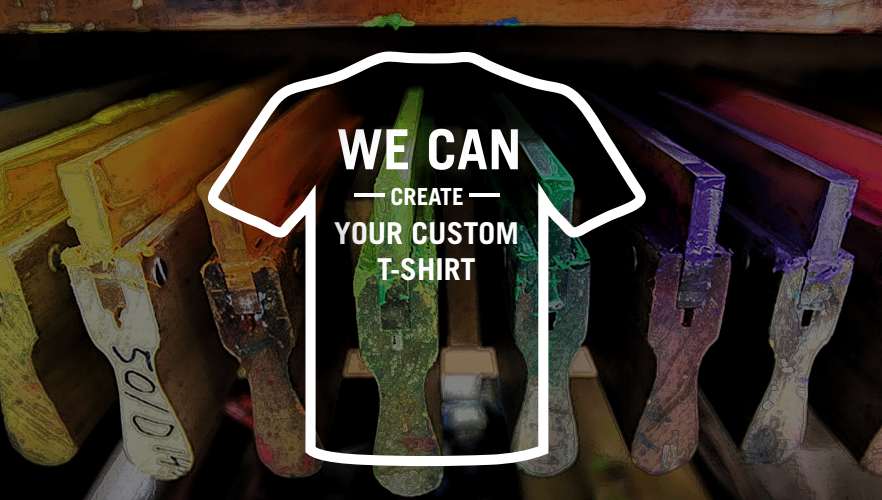Fast Turnaround Custom Screen Printing for Events
Fast Turnaround Custom Screen Printing for Events
Blog Article
Screen Printing Uncovered: Whatever You Required to Learn About Tee Shirt and Garment Printing Techniques
If you have actually ever asked yourself exactly how those vivid layouts wind up on your favorite tee shirts, you're in the ideal place. Display printing is a remarkable technique that incorporates art with technique, supplying endless opportunities for creativity. Understanding the basics, from equipment to ink options, can greatly influence your results. Prepared to check out the crucial aspects that make display publishing an art kind? Let's reveal the information that can raise your jobs.
The Basics of Screen Printing: Exactly How It Functions
When you dive into screen printing, you'll find it's both a science and an art. At its core, display printing entails developing a pattern, or screen, that allows ink to pass through just in details areas (screen printing kit). You start by choosing your layout and preparing your screen with a light-sensitive solution. Once you subject this emulsion to light, it hardens, leaving your style as an unfavorable space.
Following, you'll blend your inks and prepare your printing surface. Position the screen over the textile, after that make use of a squeegee to push ink via the display onto the garment. This process requires accuracy, as you want clear, dynamic prints. After printing, you'll treat the ink with heat, guaranteeing it follows the textile and lasts through laundries. Each action is crucial, and grasping them will certainly elevate your display printing skills, changing basic garments right into distinct, expressive items.
Kinds Of Screen Printing Strategies
As soon as you understand the essentials of display printing, it's time to explore the various methods that can raise your designs. One popular approach is traditional display printing, where ink is pushed through a stenciled screen. This strategy is fantastic for strong, vibrant shades. Then there's water-based ink printing, which uses a softer feel and is environment-friendly, however it requires a various approach to treating.
If you're aiming for great information, take into consideration discharge printing. This technique gets rid of dye from the fabric, leaving a soft, vintage appearance. One more option is plastisol printing, known for its toughness and dazzling colors, making it a preferred for several brand names. Experiment with halftone printing to create gradient impacts and intricate styles. Each strategy has its special beauty, so don't wait to try them out to find what matches your style best!
Necessary Tools for Display Printing
To achieve stunning lead to screen printing, having the appropriate tools is essential. You'll require a strong display printing structure, which holds the mesh that transfers your style onto the garment. Next, buy top quality mops; these are crucial for applying ink evenly throughout the screen. You'll also call for an excellent exposure system to produce your screens, in addition to a washout cubicle for cleansing them after usage. A reputable warmth resource, like a conveyor clothes dryer or heat press, is essential for treating your prints to assure long life. Do not fail to remember a proper work space, furnished with tables and storage space for your products. Ultimately, protective gear, such as handwear covers and masks, will keep you secure from chemicals and inks. With the right devices, you'll be well on your method to generating professional-quality prints.
Choosing the Right Inks and Materials
When picking inks and materials for display printing, you need to take into account the sort of ink that functions finest for your task. Think of material compatibility to ensure your designs look last and terrific lengthy. Discover green ink options to make your printing process more lasting.
Kinds Of Screen Inks
Selecting the appropriate display ink is vital for accomplishing lively, durable prints that fulfill your task's demands. There are numerous types of screen inks to check out. Specialty inks, such as glow-in-the-dark or metal, can add special impacts to your layouts.

Fabric Compatibility Factors To Consider
Comprehending fabric compatibility is important for attaining premium display prints, particularly given that various products react distinctively to various inks. When selecting inks, think about the fabric type-- cotton, polyester, or blends. For cotton, water-based inks work well, using softness and breathability. Polyester, on the other hand, often requires plastisol inks for much better bond and dynamic colors. You may need to use a mix of both types if you're publishing on blends. Always check your inks on sample material to assure they stick correctly and maintain color stability. In addition, bear in mind that material weight and appearance can influence the last end result, so picking the best ink and material combination is important for your project's success.
Eco-Friendly Ink Options
Green inks are coming to be a popular option for display printers who want to reduce their ecological effect while keeping high quality. When choosing inks, think about water-based inks, which are less hazardous and simpler to cleanse up compared to standard solvents.
Furthermore, search for inks made from renewable energies, such as soy or vegetable-based options. By selecting the appropriate inks and products, you'll not only create spectacular designs but likewise add to a more lasting printing process. Make the switch, and your prints will certainly show your commitment to the setting!
Preparing Your Layout for Screen Printing

File Format Demands
To assure your layout looks lively and sharp on fabric, you'll require to pay close interest to file style needs for display printing. Make certain your design has a transparent background to avoid unwanted white edges on your prints. Keep color modes in mind; CMYK is typical for screen printing, so transform your RGB creates accordingly.
Shade Separation Techniques
Color splitting up is an essential action in preparing your style for display printing, and grasping it can substantially enhance your print high quality. You'll require to break your style into specific colors, as each color needs a different display throughout printing. This precision not only assures precise color representation however likewise simplifies the printing process.
Resolution and Dimension
Achieving the finest outcomes in display printing begins with ensuring your style has the ideal resolution and dimension. Ideally, your art work should be at the very least 300 DPI (dots per inch) for sharp, clear prints. Your final product could look amateur and pixelated. if you use lower resolution.
When it involves dimension, think about the measurements of your print location. Style your artwork to match the final print size, preferably creating it in the real measurements you'll be printing. This method, you'll prevent any type of unexpected scaling issues.
Always examine your layout in both vector and raster layouts. Vector graphics can be scaled without losing top quality, making them ideal for screen printing. Preparing properly will guarantee your layout looks impressive on every garment!
Step-by-Step Display Printing Process
Screen printing is a vibrant process that permits you to create dynamic designs on different surface areas. To get going, you'll require a display, emulsion, and your chosen ink. Initially, prepare your display by cleaning it completely. Next off, apply the solution uniformly and allow it dry in a dark area. As soon as completely dry, subject your display to light with your design positioned on it, which will set the solution where the light hits, producing a pattern - screen printing kit.
After washing out the unexposed emulsion, your display prepares. Establish it up on your printing surface area and align your garment below it. Pour ink onto the display and use a squeegee to push the ink via the stencil onto he said the material. Lift the screen very carefully and allow the print completely dry. Ultimately, heal the ink utilizing heat to assure durability. That's it! You've successfully display published your layout.
Tips for Successful Screen Printing Projects
While you're diving right into your display printing jobs, keep in mind that prep work is essential to success. Begin by gathering all your materials-- inks, mops, garments, and screens. A clean work space helps avoid unwanted mistakes, so clean up prior to you begin.
Next, validate your artwork is high-resolution and properly sized for your garment. Test your screen for proper exposure and tidy it completely to stay clear of smudges. When mixing your inks, adhere to the maker's standards to accomplish the appropriate consistency.
During printing, use also pressure with your squeegee for regular results. Don't hurry; take your time to validate each print fulfills your standards. After printing, let your garments completely dry totally before dealing with or packaging them.
Lastly, always maintain a sample of your help future recommendation. This way, you can analyze your progression and enhance your strategies in time. Happy printing!

Often Asked Concerns
For how long Does It Take to Establish a Display Printing Work?
Establishing a display printing job normally takes around thirty minutes to an hour. You'll prepare the screens, mix inks, and change the press. The moment differs based on complexity and experience, so remain arranged!
Can I Print on Different Fabric Keys In Utilizing the Very Same Method?
Yes, you can print on different fabric types using the very same method, however you'll need to change your inks and setups. Some textiles take in ink in different ways, so exploring assurances the finest results for each and every product.
What Prevail Blunders to Stay Clear Of in Screen Printing?
When screen printing, stay clear of typical mistakes like making use of the incorrect ink, overlooking proper direct exposure times, or skipping pre-press checks. Constantly check your configuration and keep clean displays to ensure top quality results each time.
Just How Can I Appropriately Clean and Preserve My Display Printing Equipment?
To effectively clean and keep your screen printing tools, you ought to on a regular basis clean displays with appropriate go to this website solvents, inspect squeegees for wear, and guarantee all devices are saved dust-free and completely dry. Consistency avoids costly repairs and improves efficiency.
Is Screen Printing Ecologically Pleasant Compared to Other Approaches?
Display printing can be much more eco-friendly than other techniques, particularly if you use water-based inks and eco-conscious products. By choosing sustainable materials and practices, you lower waste and lessen your impact on the earth.
Display Printing Uncovered: Every Little Thing You Need to Know About Tee Shirt and Garment Printing Techniques
At its core, display printing involves producing a stencil, or screen, that enables ink to pass via just in specific areas. Setting the screen over the material, then utilize a squeegee to press ink through the display onto the garment. One preferred method is typical display printing, where ink is pushed with a stenciled screen.When selecting inks and products for screen printing, you need to take into account the type of ink that works finest for your task.
Report this page